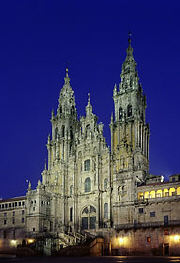Santiago de Compostela
Santiago de Compostela, considered the holiest city in Spain, is tucked away in the far end of northwest Spain. Most travelers to Spain have long heard about the Camino de Santiago, the medieval pilgrimage route that ends at that town’s cathedral. Even though the route is technically called the Way of Saint James, or the Camino de Santiago, you’ll probably hear people talking about walking the Santiago de Compostela route as well. These days, it’s more of a popular hiker’s trail than a pilgrimage route – there are several routes you can take, starting from France, Portugal or several points in Spain.
Santiago de Compostela is perhaps the most popular destination in Galicia, attracting people from all corners of the world with its magnificent cathedral and prestigious Christian reputation. The entire city is a UNESCO World Heritage Site, and boasts a beautiful historic center and a university which was founded in the 16th century. It’s the city’s cathedral is also the end point for Camino de Santiago, the most popular Spanish hiking trail.
What to do
The Cathedral
 Inside the Santiago de Compostela Cathedral is said to be the burial place of Saint James the Great, one of the 12 apostles, who (legend says) came to the Iberian Peninsula preaching the gospel before being killed in Jerusalem in 44 AD. The legend continues that his remains were brought back to Galicia and a church at Santiago de Compostela was constructed to hold the holy relics in the 9th century. The present-day cathedral dates from 1075, and the holiness of the relics interred there has been debated – a Papal Bull in the 1880s gave them the official seal of approval, but the Vatican today doesn’t sound as convinced. That doesn’t stop tens of thousands of people from making the pilgrimage to the cathedral every year.
Inside the Santiago de Compostela Cathedral is said to be the burial place of Saint James the Great, one of the 12 apostles, who (legend says) came to the Iberian Peninsula preaching the gospel before being killed in Jerusalem in 44 AD. The legend continues that his remains were brought back to Galicia and a church at Santiago de Compostela was constructed to hold the holy relics in the 9th century. The present-day cathedral dates from 1075, and the holiness of the relics interred there has been debated – a Papal Bull in the 1880s gave them the official seal of approval, but the Vatican today doesn’t sound as convinced. That doesn’t stop tens of thousands of people from making the pilgrimage to the cathedral every year.
Whether you’re walking the Camino de Santiago or just visiting Santiago de Compostela, you can enjoy a noon mass for pilgrims held every day in the cathedral. This Pilgrim’s Mass allows those who have received their compostela certificate to say where they’re from and where they started their pilgrimage.
Since the time when the remains of St. James were placed in the first church in Galicia in the 9th century, the location has been the destination for the Way of Saint James. El Camino de Santiago was, during medieval times, one of the most important Christian pilgrimages a person could make. While the destination is always the same, there are actually a few routes by which people can get there. Some of the routes are more popular and more well-traveled, and the route itself has also been added to the list of UNESCO World Heritage Sites.
Besides the Cathedral, the city’s old town is worth spending some time exploring. The entire historical centre is packed with treasure troves and testiments from yesteryears. Every street corner offers something for the curious traveler – from ancient chapels to charming fountains and vintage taverns.
Getting there
Santiago Airport is located approximately 8km from the city centre of Santiago de Compostela. It is easily connected to the city center by buses; several bus lines from Empresa Friere run directly from the airport to the historical centre. Taxis from the airport to the main city cost about 20 EUR.
Where to stay
There are a variety of places to stay, varying in price range and style, that exist in convenient locations around Santiago de Compostela. The best location to stay at is in the historical quarters, although prices are also the highest here. For travelers who like a bargain, there are many inexpensive hostels in Santiago de Compostela that provide comfortable rooms, a great location, and a beautiful view of the Cathedral for both families and groups of friends. There are also several hotels in Santiago de Compostela and short-term-apartments that have prices ranging down to €37 a night.